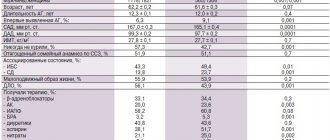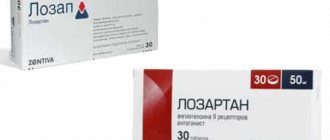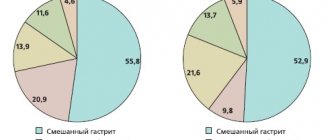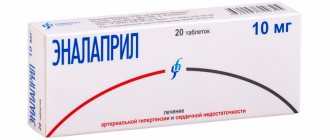Moxonidine ~ Alpha2-adrenomimetic central
Price in pharmacies from 90.90 to 399.00 rubles*
A selective agonist of imidazoline receptors, is involved in the tonic and reflex regulation of the sympathetic nervous system (localized in the ventrolateral medulla oblongata). Reduces the pressor effect of the sympathetic system on peripheral vessels, reduces peripheral vascular resistance, reduces systolic and diastolic blood pressure (BP) both with a single dose and with long-term use, while cardiac output and heart rate (HR) do not change significantly . With long-term use, it reduces left ventricular myocardial hypertrophy, smoothes out the signs of myocardial fibrosis, microarteriopathy, and normalizes capillary blood supply to the myocardium. During treatment, the activity of norepinephrine and epinephrine, renin, angiotensin II at rest and during exercise, atrial natriuretic peptide (with exercise) and plasma aldosterone decreases. More about the drug »
ATTENTION! ALWAYS check with your doctor or pharmacist to see if the found analogue can serve as a full replacement for the drug prescribed to you or the drug you are looking for. This is due to the need to use the dosage forms and doses prescribed specifically for you, which may differ even among analogues (more about analogues of drugs).
pharmachologic effect
Manufacturer: Severnaya Zvezda and others, Russia
Release form: tablets
Active ingredient: moxonidine
The drug contains the active ingredient of the same name – moxonidine. The drug is an antihypertensive, which has a central mechanism of action. With regular use, there is an improvement in the patient's condition, as well as stabilization of blood pressure.
Moxonidine - instructions for use
According to the instructions for use, Moxonidine is intended for oral use.
The dosage and duration of therapy is adjusted by the cardiologist and depends on the general condition of the patient.
If a negative reaction occurs, it is necessary to exclude independent interruption of treatment and seek additional advice from a specialist.
It is recommended to start therapy with a dosage of Moxonidine 0.2 mg per day. You are allowed to consume no more than 0.4 mg at a time. It is recommended to swallow the tablets and drink plenty of water.
As for patients with renal failure, in this situation additional consultation with a urologist is required.
How to take Moxonidine: before or after meals
It is allowed to take both before and after meals. Food has no effect on pharmacokinetics. If you take the tablets before meals, it is better to do it 30–40 minutes before or 45–60 minutes after.
About the drug
Moxonidine is an antihypertensive drug, part of the group of imidazoline receptor agonists. The active component has a similar name. The mechanism of action is the binding of these receptors, resulting in decreased control over the reflex control of the sympathetic nervous system.
The drug is more often used for the treatment of arterial hypertension in patients with diabetes and obesity. Such patients are more often diagnosed with isolated and poorly controlled hypertension. This medicine helps to cope with high blood pressure and prevent the development of complications, as evidenced by reviews from doctors and patients.
The drug is contraindicated if you are allergic to its components, during pregnancy and lactation, and under the age of 18 years. Other contraindications:
- Bradycardia with a rhythm of less than 50 beats per minute, sick sinus syndrome (SSNS), sinoatrial and atrioventricular blocks, severe arrhythmias.
- Obliterating atherosclerosis of the lower extremities.
- Severe forms of angina.
- Syndrome or Raynaud's disease.
- Depression.
- Epilepsy, extrapyramidal disorders.
- Glaucoma.
- Severe pathologies of the liver and kidneys.
Undesirable effects: asthenia, sleep disturbances, cephalalgia, dizziness, peripheral edema, dry mouth.
The product is available in tablets of 0.2 mg and 0.4 mg. Therapy begins with 0.2-0.4 mg per day. The maximum amount of medication per day is 0.6 mg (the dose is divided into 2 doses). The price of Moxonidine-SZ is 130-250 rubles, Moxonidine Canon is 70-190 rubles. The shelf life is more than a year, or more precisely 2-3 years.
Moxonidine analogs
Pharmacies offer a large selection of Moxonidine analogues Canon and North Star (SZ). The drugs differ in their basic composition, packaging and manufacturers. The selection of funds is carried out exclusively by a cardiologist.
SPTs of Moxonidine analogues with prices
| Drug name | price, rub. | Manufacturer country |
| Moxonidine | 180-440 | Russia |
| Moxonidine Canon | 110-180 | |
| Popular substitutes | ||
| Captopril | 40-160 | Germany, Russia |
| Moxonitex | 170-400 | Germany |
| Moxarel | 260-430 | Russia |
| Physiotens | 280-900 | |
| Kapoten | 170-320 | |
| Other analogues | ||
| Amlodipine | 110-170 | Serbia |
| Cordaflex | 90-240 | Hungary |
| Tenzotran | 690-720 | Israel |
| Corinfar | 70-160 | Croatia |
| Lerkamen | 440-1200 | Germany |
| Indapamide | 90-130 | Russia |
| Nifedipine | 40-55 | |
| Losartan | 50-170 | |
| Lisinopril | 30-250 | |
| Enalapril | 20-220 | |
| Prestarium | 380-600 | |
| Lorista | 150-970 | |
| Perindopril | 230-500 | |
| Lozap | 280-770 | Slovenia |
| Valsacor | 38-1200 | |
Moxonidine or Physiotens - which is better and more effective, what is the difference
Manufacturer: Abbott Laboratories EPD, Russia
Release form: tablets
Active ingredient: moxonidine
Physiotens is a domestic analogue of Moxonidine, which is an antihypertensive agent. The mechanism of action depends on the main component. With regular use of the drug, a gradual decrease in blood pressure is observed.
After consumption, it is quickly and almost completely absorbed in the upper gastrointestinal tract. A distinctive feature of the Russian analogue is its inflated cost.
Reviews from doctors about these drugs for arterial hypertension are positive, as they help cope with the problem, stabilize the condition and have the same active ingredient.
Moxonidine
Suction
After oral administration, moxonidine is rapidly and almost completely absorbed from the upper gastrointestinal tract (about 90%). Absolute bioavailability is approximately 88%, indicating no significant first-pass effect. The time to reach maximum concentration is about 1 hour. Food intake does not affect the pharmacokinetics of the drug.
Distribution
The binding to plasma proteins is 7.2%.
Metabolism
The main metabolite is dehydrogenated moxonidine. The pharmacodynamic activity of dehydrogenated moxonidine is about 10% compared to moxonidine.
Removal
The half-life (T1/2) of moxonidine and its metabolite is 2.5 and 5 hours, respectively. Within 24 hours, over 90% of moxonidine is excreted by the kidneys (about 78% unchanged, 13% as dehydrated moxonidine, other metabolites in the urine do not exceed 8% of the dose taken). Less than 1% of the dose is excreted through the intestines.
Pharmacokinetics in patients with arterial hypertension
Compared with healthy volunteers, patients with arterial hypertension show no changes in the pharmacokinetics of moxonidine.
Pharmacokinetics in old age
Clinically insignificant changes in the pharmacokinetic parameters of moxonidine were noted in elderly patients, probably due to a decrease in the intensity of its metabolism and/or slightly higher bioavailability.
Pharmacokinetics in children
Moxonidine is not recommended for use in persons under 18 years of age, and therefore no pharmacokinetic studies have been conducted in this group.
Pharmacokinetics in renal failure
Moxonidine excretion is significantly correlated with creatinine clearance (CC). In patients with moderate renal failure (creatinine clearance in the range of 30-60 ml/min), steady-state plasma concentrations and final T1/2 are approximately 2 and 1.5 times higher, respectively, than in individuals with normal renal function (creatinine clearance more than 90 ml /min).
In patients with severe renal failure (creatinine clearance less than 30 ml/min), steady-state plasma concentrations and final T1/2 are 3 times higher than in patients with normal renal function.
The administration of multiple doses of moxonidine leads to predictable accumulation in the body of patients with moderate and severe renal failure.
In patients with end-stage renal failure (creatinine clearance less than 10 ml/min) on hemodialysis, steady-state plasma concentrations and final T1/2 are 6 and 4 times higher, respectively, than in patients with normal renal function.
In patients with moderate renal failure, the maximum concentration of moxonidine in the blood plasma is 1.5-2 times higher. In patients with impaired renal function, the dosage should be adjusted individually. Moxonidine is excreted to a small extent during hemodialysis.
Moxonidine or Capoten - which is better during a crisis
Manufacturer: AKRIKHIN, Russia
Release form: tablets
Active ingredient: captopril
Kapoten is a domestically produced substitute for Moxonidine. This is a prescription drug that is an ACE inhibitor. The positive effect of administration and stabilization of the patient’s condition is observed 60–90 minutes after ingestion.
The drug is prescribed to patients of the older age category. Moxonidine analogue SZ Kapoten has an extensive list of indications, which include:
- High blood pressure.
- Chronic heart failure (CHF).
- Coronary heart disease (CHD).
- Diabetic nephropathy in insulin-dependent diabetes mellitus.
In case of hypertensive crisis, it is allowed to use both Moxonidine and its analogue Capoten.
Moxonidine or Captopril - which is better during a crisis
Manufacturer: SANDOS, Germany
Release form: tablets
Active ingredient: captopril
If you don’t know how to replace Moxonidine for hypertension, then use the ACE inhibitor – Captopril. It is an antihypertensive agent that has a vasodilator effect. If you take the tablets for a long time, the severity of left ventricular myocardial hypertrophy decreases. The drug has a vasodilating effect mainly on the arteries and improves blood supply to the ischemic myocardium.
Indications for the use of this cheap analogue of Moxonidine are related to the pharmacology of this drug:
- High blood pressure.
- CHF (chronic heart failure).
- Impaired left ventricular functionality after myocardial infarction.
- Diabetic nephropathy in type 1 diabetes mellitus.
In case of hypertensive crisis, experts recommend taking an imported analogue of the drug Moxonidine - Captopril. This is explained by the fact that the drug has extensive indications and effective pharmacological action, as well as positive reviews.
Tenzotran or Moxonidine – what to choose
Tenzotran is another imported analogue of Moxonidine, produced by the Icelandic company Actavis in tablets of 0.2 mg and 0.4 mg. Indications for use: essential and secondary arterial hypertension, accompanied by obesity and diabetes mellitus.
Tenzotran is not prescribed for SSSU, bradycardia, blockades of the conduction system of the heart, severe angina and heart failure, allergies, liver and kidney diseases of severe severity, and disorders of carbohydrate metabolism. The medicine is not used for the treatment of pregnant and lactating women, persons under 18 years of age.
Among the adverse reactions, the following were recorded: drowsiness, fatigue, headaches and dizziness, orthostatic hypotension, peripheral circulatory disorders, dry mucous membranes of the oral cavity and organ of vision.
The dosage regimen for Tenzotran is the same as for any drug with moxonidine as an active ingredient. The price per package is in the range of 150-600 rubles.
[t_price foo=”Tensotran”]
Moxonidine or Moxonitex – which is better?
Manufacturer: SANDOS, Germany
Release form: tablets
Active ingredient: moxonidine
Moxonitex is a foreign, prescription analogue. The drug is a selective agonist of imidazoline receptors. If you take the drug for a long time, the risk of developing left ventricular myocardial hypertrophy is reduced. Has no effect on heart rate.
After consuming the tablet, the patient’s condition stabilizes within 30–60 minutes. The duration of action is more than 12 hours.
The analogue is prescribed to patients of the older age group exclusively with high blood pressure.
Moxonidine or Moxarel – which is better?
Manufacturer: VETEKS, Russia
Release form: tablets
Active ingredient: moxonidine
Moxarel is an analogue of the active substance. It has antihypertensive properties with a central mechanism of action. Does not develop a sedative effect. After oral administration, dryness of the oral mucosa is not observed. The drug reduces systemic vascular resistance and blood pressure.
Prescribed to patients of the older age group with hypertension. The duration of the course and dosage are adjusted by the cardiologist depending on the general condition.
Self-therapy should be completely excluded, as this will lead to negative consequences.
Moxarel or Moxonidine – which helps better?
Moxarel is another direct analogue that can be easily purchased at the pharmacy. The medicine is produced by the Russian company Vertex in dosages of 0.2 mg, 0.3 mg and 0.4 mg. The mechanism of action, indications, contraindications and adverse reactions are the same as for any drug with moxonidine as an active component.
The dosage regimen of Moxarel is also no different from previous analogues. The difference lies in the presence of a dosage of 0.3 mg, which opens up more opportunities for adjusting the treatment regimen. The price for Moxarel ranges from 250 to 400 rubles per pack.
[t_price foo=”Moxarel”]
Which is better: Moxonidine or Moxonidine Canon
Manufacturer: KANOPHARMA, Russia
Release form: tablets
Active ingredient: moxonidine
Moxonidine Canon is a selective imidazoline receptor agonist. The drug is able to reduce systolic and diastolic blood pressure even after a single dose. Has no effect on heart rate. If the drug is used for a long time, the risk of left ventricular myocardial hypertrophy is reduced.
It is also prescribed to patients over 18 years of age with high blood pressure.
The main difference between Moxonidine Canon and Moxonidine SZ is the cost: the latter is a third more expensive.
Buy Moxonidine SZ tablets 0.4 mg No. 28 in pharmacies
Instructions for use
Moxonidine-SZ tab. 0.4 mg No. 28
Dosage forms
tablets 0.4 mg Synonyms Moxarel Moxonidine Canon Moxonitex Tenzotran Physiotens Group Antihypertensive - imidazoline receptor agonists International nonproprietary name Moxonidine Composition Active ingredient - Moxonidine. Manufacturers North Star (Russia)
Pharmacological action Antihypertensive. It is an agonist of pre- and postsynaptic alpha2-adrenergic receptors. Quickly and almost completely absorbed from the gastrointestinal tract. It is excreted unchanged in the urine. The interval between reaching the maximum concentration and a pronounced decrease in blood pressure is 2-4 hours. The duration of action is more than 12 hours (it is slowly eliminated from the central nervous system and reduces the concentration of adrenaline in plasma for a long time). Reduces left ventricular myocardial hypertrophy, eliminates signs of myocardial fibrosis, microarteriopathy, and normalizes capillary blood supply to the myocardium. Reduces total peripheral vascular resistance, pulmonary vascular resistance, blood levels of renin and angiotensin II, adrenaline and norepinephrine at rest and during exercise, atrial natriuretic factor (with exercise), and aldosterone. Reduces tissue resistance to insulin, stimulates the release of growth hormone. Side effects Dry mouth (at the beginning of treatment), fatigue, weakness, headaches, dizziness, central nervous system depression, peripheral edema. Indications for use Arterial hypertension; metabolic syndrome. Contraindications Hypersensitivity, sick sinus syndrome, impaired sinoatrial and AV conduction II-III degree, bradycardia less than 50 beats per minute, severe cardiac arrhythmias, heart failure (NYHA functional class IV), unstable angina, severe liver and kidney dysfunction, peripheral circulatory disorders (obliterating atherosclerosis of the vessels of the lower extremities with intermittent claudication syndrome, Raynaud's disease), Parkinson's disease, depressive states, epilepsy, glaucoma, pregnancy, breastfeeding (stopped during treatment), adolescence (up to 16 years). Method of administration and dosage: Orally, during or after meals, with a small amount of liquid - 0.2 mg 1 time per day (in the morning). If there is no effect (after 3 weeks) - 0.4 mg once (in the morning) or 0.2 mg 2 times a day (morning and evening). A single dose should not exceed 0.4 mg, a daily dose of 0.6 mg, in case of renal failure a single dose should not exceed 0.2 mg, a daily dose of 0.4 mg. Overdose Symptoms: hypotension, dry mouth, palpitations, weakness, drowsiness. Treatment: symptomatic. Idazoxan (an imidazoline antagonist) is administered as a specific antidote. Interaction Strengthens (mutually) the effect of other antihypertensive drugs, depressants (alcohol, tranquilizers, barbiturates, antipsychotics). Special instructions Use with caution in renal failure. During treatment, alcohol consumption is excluded; it is not recommended (especially at the beginning of treatment) to work with mechanisms that require increased attention and speed of reaction. Storage conditions List B. At room temperature.
Nifedipine
Manufacturer: OZON, Russia
Release form: tablets
Active ingredient: nifedipine
Nifedipine is a prescription drug, an inexpensive analogue. The composition includes the active ingredient of the same name. The drug is a selective class 2 calcium channel blocker. Has antianginal and hypotensive effects. Has almost no antiarrhythmic activity.
Prescribed for the prevention of angina attacks, as well as for arterial hypertension, hypertensive crisis and Raynaud's disease.
Moxonidine analogues are antihypertensive drugs that are recommended for patients in the older age group with high blood pressure. Most substitutes have extended indications that are related to pharmacology and active ingredients.







